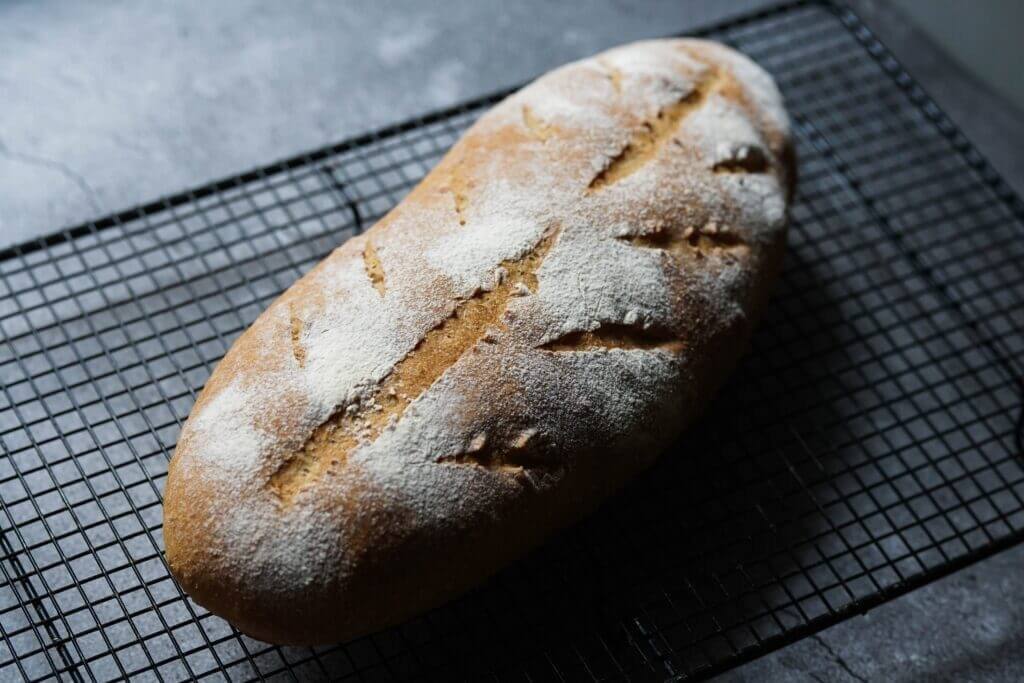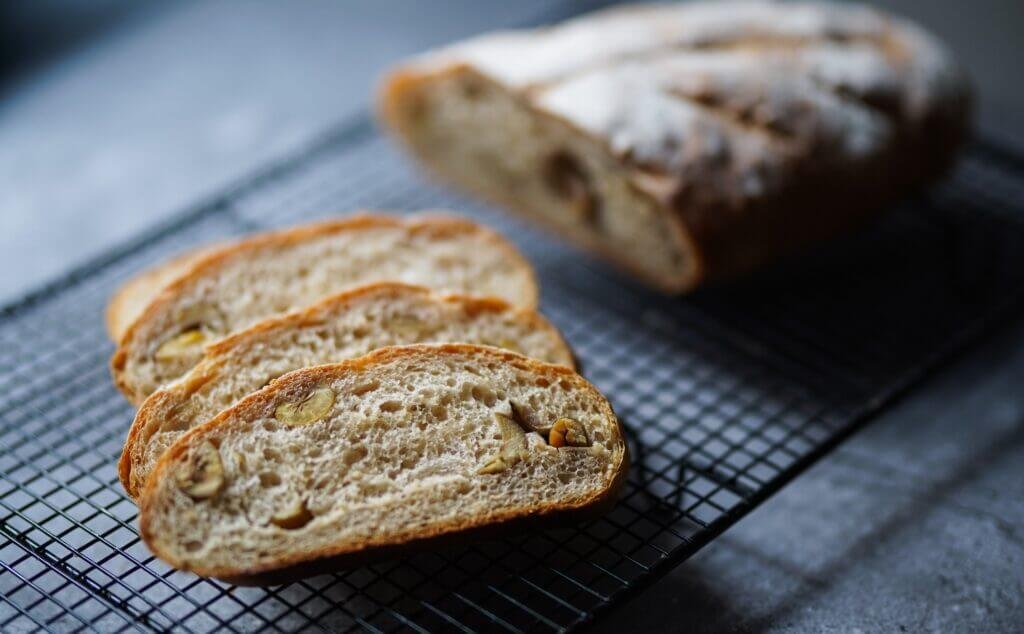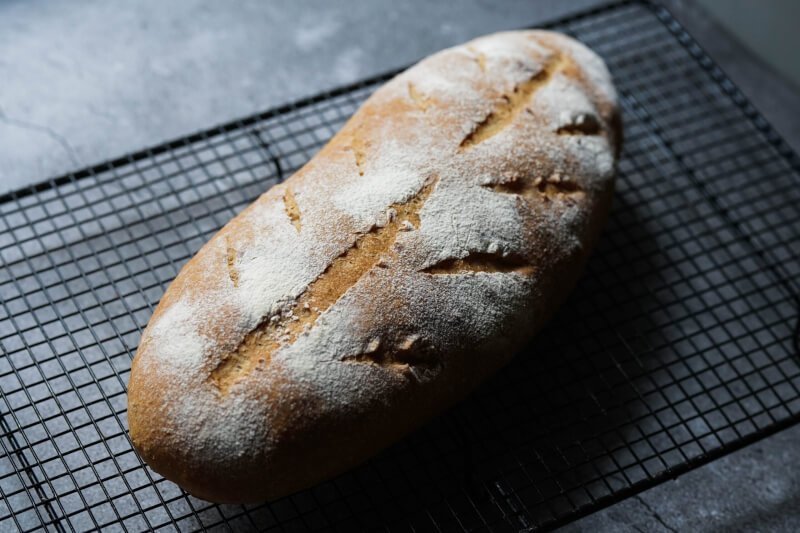So you’ve caught the homemade bread bug and you’re eager to jump on the sourdough bandwagon. You find yourself daydreaming about the perfect loaf with its crusty exterior and fluffy interior, but there’s just one problem – you need a sourdough starter. Fear not, my friend, because it’s actually quite simple to make your own. All you need is a little patience, some flour, and a touch of water to create a living ecosystem of wild yeast and bacteria that will transform your bread-making game forever. In this article, we’ll guide you through the steps to create your own sourdough starter, unlocking a world of tangy, complex flavors and endless baking possibilities.
Choosing the Right Flour
When it comes to making sourdough starter, choosing the right flour is essential. Different types of flour can greatly affect the development and flavor of your starter. Two commonly used types of flour are whole wheat flour and all-purpose flour.

Types of Flour to Use
Whole wheat flour is made from grinding the entire wheat kernel, which includes the bran, germ, and endosperm. It is known for its higher nutritional content and stronger flavor. Whole wheat flour provides a rich and hearty taste to your sourdough.
On the other hand, all-purpose flour is a more refined flour that is often used in baking. It is made from a mixture of both hard and soft wheat, resulting in a versatile flour that works well in many recipes, including sourdough starters. All-purpose flour has a milder flavor compared to whole wheat flour.
Whole Wheat vs. All-Purpose Flour
The choice between whole wheat flour and all-purpose flour depends on personal preference and the desired outcome. If you prefer a more robust and wholesome flavor, whole wheat flour is the way to go. On the other hand, if you prefer a milder flavor and a lighter texture, all-purpose flour is a better option.
Organic vs. Non-Organic Flour
Another aspect to consider when choosing flour for your sourdough starter is whether to go for organic or non-organic flour. Organic flour is produced without the use of synthetic pesticides, chemicals, or genetically modified organisms (GMOs). It is considered a healthier and more environmentally friendly option.
Non-organic flour, on the other hand, is produced using conventional farming methods. It may contain traces of pesticides and other chemical residues. While these traces are generally safe to consume in small amounts, some people prefer to avoid them and opt for organic flour.
When it comes down to it, the choice between organic and non-organic flour is a personal one. Consider your own preferences, values, and availability when deciding which type of flour to use for your sourdough starter.
Gathering the Ingredients
Before diving into the process of creating a sourdough starter, it’s important to gather all the necessary ingredients. The key ingredients for a basic sourdough starter are flour and water. However, there is an optional ingredient that can help jumpstart the fermentation process – pineapple juice.
Flour
As mentioned earlier, the choice of flour is crucial. Whether you decide to use whole wheat flour or all-purpose flour, make sure it is fresh and of good quality. Stale or expired flour may not have enough active yeast and bacteria to successfully ferment your starter.
Water
Water is another essential ingredient in creating a sourdough starter. It is recommended to use filtered or chlorine-free water to avoid any potential interference with the fermentation process. Chlorine in tap water can inhibit the growth of yeast and bacteria, so it’s best to use water that has been dechlorinated.
Optional: Pineapple Juice
While not necessary, pineapple juice can be added to the initial mixture of flour and water to create an environment that is favorable for the growth of beneficial bacteria and yeast. The acidity of pineapple juice helps prevent the growth of undesirable bacteria, creating a more controlled fermentation process.
If you choose to use pineapple juice, make sure to opt for 100% pure pineapple juice without any additives. The juice should not contain any preservatives, as they can interfere with the natural fermentation process.
Understanding the Science Behind Sourdough Starter
To successfully create and maintain a sourdough starter, it is helpful to have a basic understanding of the science behind the fermentation process. Fermentation, wild yeast, bacteria, pH, and temperature all play significant roles in the creation and development of a sourdough starter.
What is Fermentation?
Fermentation is a natural process that occurs when microorganisms, such as yeast and bacteria, break down sugars in the presence of moisture. In the case of sourdough starter, fermentation is essential to create the distinctive tangy flavor and texture.
During fermentation, the yeast in the starter consumes the sugars in the flour and excretes carbon dioxide gas and alcohol. This process helps leaven the bread and gives it its characteristic airy texture. The bacteria present in the starter then convert the alcohol into lactic and acetic acids, which contribute to the unique sour taste.

Role of Wild Yeast and Bacteria
Wild yeast and bacteria are the key players in the fermentation process of sourdough starter. They naturally occur in the environment, especially in the skins of fruits and grains. Unlike commercial yeast, wild yeast is not a single strain but a diverse mixture of various strains.
The wild yeast in the starter feeds on the natural sugars in the flour, releasing carbon dioxide and alcohol as byproducts. This gas production causes the dough to rise, resulting in a light and airy texture.
The bacteria present in the starter, particularly the lactic acid bacteria, produce lactic and acetic acids. These acids lower the pH of the starter, creating an acidic environment that prevents the growth of harmful bacteria and enhances the flavor of the bread.
pH and Temperature Considerations
The pH level and temperature of your sourdough starter are crucial factors that determine the growth and activity of yeast and bacteria. The ideal pH range for a sourdough starter is slightly acidic, typically around 4 to 5. This acidity inhibits the growth of unwanted bacteria, providing an environment conducive to the growth of beneficial microorganisms.
Temperature also plays a significant role in the fermentation process. The activity of yeast and bacteria is influenced by temperature, with warmer temperatures generally promoting faster fermentation. However, extreme temperatures can negatively affect the balance of yeast and bacteria in the starter, leading to undesirable results.
It’s important to strike a balance between pH and temperature to ensure the optimal growth of yeast and bacteria in your sourdough starter. Regular maintenance, feeding, and monitoring of these conditions will help create a healthy and active starter.
Step-by-Step Guide to Creating a Sourdough Starter
Creating a sourdough starter from scratch requires a few simple steps spread over several days. This method, often referred to as the “pineapple juice method,” is a commonly recommended technique for beginners.
Day 1: Mixing Flour and Water
On the first day, begin by mixing equal parts of flour and water in a clean container. For example, you can start with 50 grams of flour and 50 grams of water. If using pineapple juice, substitute 10% of the water with pineapple juice (e.g., 5 grams of pineapple juice and 45 grams of water).
Stir the mixture well until all the flour is hydrated, ensuring no dry clumps remain. Cover the container loosely with a clean kitchen towel or plastic wrap and leave it at room temperature for approximately 24 hours.
Day 2: Discarding and Feeding the Starter
On the second day, you may begin to see some initial signs of fermentation in the form of bubbles and a slightly sour smell. At this point, you need to discard about half of the mixture to allow for consistent growth and prevent excess acidity.
Remove half of the starter (approximately 50 grams) and discard it. Add 50 grams of fresh flour and 50 grams of water to the remaining starter. Mix well and cover loosely. Leave the container at room temperature for another 24 hours.
Day 3: Regular Feeding and Maintenance Schedule
By the third day, your sourdough starter should be showing signs of regular fermentation. Bubbles should be more pronounced, and the starter should have a tangy, slightly acidic smell.
To establish a regular feeding and maintenance schedule, it’s important to discard and feed your starter at consistent intervals. Start by discarding about half of the starter and then adding equal amounts of fresh flour and water (e.g., 50 grams each) to the remaining starter. Mix well, cover loosely, and let it sit at room temperature.
Repeat this process of discarding and feeding at 12 to 24-hour intervals for the next few days, or until your starter becomes active and doubles in size within a few hours after feeding. This indicates a healthy and well-established sourdough starter.
Troubleshooting Common Issues
While creating and maintaining a sourdough starter is generally a straightforward process, issues can occasionally arise. Here are some common problems you may encounter and how to troubleshoot them.
Mold Growth
If you notice mold growth on your sourdough starter, it is important to discard it immediately. Mold is a type of fungi and can be harmful if consumed. To prevent mold growth, make sure your containers and utensils are thoroughly cleaned and sanitized. Additionally, maintaining proper pH and temperature conditions can help inhibit mold growth.
No Signs of Fermentation
If your sourdough starter shows no signs of fermentation after several days, don’t panic. Patience is key in sourdough baking. Sometimes it takes longer for the wild yeast and bacteria to establish themselves. Ensure that you are using fresh ingredients, maintaining optimal pH and temperature, and following a consistent feeding schedule. If necessary, you can try adjusting the environment by using warmer or cooler temperature settings.

Unpleasant Odor
While a slightly sour and tangy smell is normal for a sourdough starter, an unpleasant or foul odor might indicate undesirable bacteria or a contaminated starter. If you encounter such an odor, it is best to discard the starter and begin again. Sanitizing your equipment and using fresh ingredients can help prevent the growth of unwanted bacteria.
Remember, troubleshooting sourdough starter issues is part of the learning process. With practice and observation, you’ll become more adept at identifying and resolving any potential problems.
Feeding and Maintaining Your Sourdough Starter
Feeding and maintaining your sourdough starter is crucial to its long-term health and performance. A well-fed and well-maintained starter will produce consistent results and bring out the best flavors in your bread.
Determining Feeding Ratio
To determine the feeding ratio for your sourdough starter, consider its current weight and desired feeding frequency. A common feeding ratio is equal parts starter, flour, and water, often referred to as a 1:1:1 ratio. For example, if your starter weighs 100 grams, you would feed it with 100 grams of flour and 100 grams of water.
Alternatively, you can adjust the feeding ratio to match your personal preferences or baking schedule. For a more liquid starter, you can increase the water content, while a drier starter requires a higher proportion of flour. Experiment with different ratios to find the consistency that works best for you.
Maintaining Storage Temperature
The storage temperature of your sourdough starter can greatly impact its activity and flavor profile. Ideally, the starter should be kept at a stable temperature between 70 to 85°F (21 to 29°C). This range provides a favorable environment for the growth of yeast and bacteria.
If your kitchen tends to be cooler or warmer than this range, consider adjusting the temperature by placing the starter near a warm spot or using a temperature-controlled environment like a proofing box. However, extreme temperatures can negatively affect the balance of microorganisms, so it’s essential to find a moderate and consistent temperature.
Developing a Feeding Schedule
Establishing a regular feeding schedule is essential for maintaining a healthy and active sourdough starter. This schedule can vary depending on factors such as personal preference, baking frequency, and the ambient temperature.
A common feeding schedule is twice a day, roughly every 12 hours. However, daily or even every-other-day feedings can also be effective, especially in cooler environments. The key is to monitor the activity of your starter and adjust the feeding frequency accordingly.
Consistency is key when it comes to feeding your sourdough starter. Regularly discarding a portion of the starter and feeding it fresh flour and water will ensure a constant supply of nutrients for the microorganisms, promoting a vigorous and active starter.
Using Your Sourdough Starter in Recipes
Once your sourdough starter is active and well-maintained, it’s time to put it to use in various recipes. While sourdough bread is the most common application, your starter can also be used to enhance the flavor and texture of other baked goods and fermented foods.
Basic Bread Recipe
Sourdough bread relies on the natural leavening power of your starter to rise. A basic sourdough bread recipe typically involves mixing flour, water, salt, and your active sourdough starter. The fermentation process gives the bread its distinct sour flavor and enhances its texture.
To make sourdough bread, start by combining the ingredients in a mixing bowl and kneading the dough until it becomes smooth and elastic. Allow the dough to rise, either at room temperature or in a refrigerator, for several hours or overnight. Shape the dough, let it proof, and bake it in a preheated oven until golden brown.
Other Baked Goods and Fermented Foods
Your sourdough starter can also be used to add depth of flavor to a wide range of baked goods and fermented foods. Try incorporating it into recipes for pancakes, waffles, muffins, and pizza dough. The tangy and complex flavor of sourdough can elevate these dishes to new heights.
You can also explore the world of fermented foods using your sourdough starter. Fermented vegetables like sauerkraut and kimchi benefit from the addition of sourdough starter as a natural source of lactic acid bacteria. The starter enhances the fermentation process and provides additional flavor complexity.
Remember, when using your sourdough starter in recipes, consider its hydration level and adjust the recipe accordingly. Higher hydration starters can require additional flour to achieve the desired consistency, while drier starters may need slight adjustments to the liquid content.
Storing and Sharing Your Sourdough Starter
If you have a healthy and active sourdough starter, you may want to consider storing it for long-term use or sharing it with friends and family who are interested in sourdough baking.
Refrigerating vs. Freezing
Refrigeration is a popular method for storing sourdough starter while maintaining its activity. To store your starter in the refrigerator, transfer it to a clean jar or airtight container and cover it loosely. Keep it refrigerated, feeding it at least once a week to keep it active. Before using the refrigerated starter, allow it to come to room temperature and refresh it with a feeding or two.
Freezing is another option for storing your sourdough starter for an extended period. Divide your starter into small portions, transfer each portion to a freezer-safe container, and seal it tightly. The frozen starter can be stored for several months or even up to a year. When ready to use, thaw the starter in the refrigerator and revive it with regular feedings until it becomes active again.
Sharing with Friends and Family
Sourdough starter has a long history of being shared among bakers, friends, and family. If you have a flourishing starter, consider sharing it with those who are interested in dabbling in sourdough baking.
To share your starter, transfer a portion of it into a clean container and provide clear instructions on how to care for and feed it. You can even prepare a small care package with additional flour and a handwritten note detailing the feeding and maintenance process. Sharing your sourdough starter is a wonderful way to spread joy and the love of baking within your community.
Exploring Flavor Variations
While classic sourdough bread is a favorite among many, there are countless ways to explore and experiment with flavor variations. By incorporating different flours, herbs, spices, and adjusting fermentation time, you can create unique and personalized sourdough creations.
Adding Different Flours
The type of flour you use in your sourdough starter greatly impacts the flavor profile of your bread. Consider experimenting with different flours, such as rye flour, spelt flour, or even buckwheat flour, to introduce new flavors. These alternative flours lend their unique characteristics, adding depth and complexity to your sourdough creations.
Incorporating Herbs and Spices
To further enhance the flavor of your sourdough bread, try incorporating herbs and spices into the dough. Finely chopped herbs like rosemary, thyme, or dill can add a delightful fragrance, while spices like cinnamon, nutmeg, or cardamom can infuse your bread with warm and comforting notes. Experiment with different combinations to find your favorite flavor profiles.
Experimenting with Fermentation Time
The length of fermentation greatly influences the flavors that develop in your sourdough bread. Longer fermentation can result in a more pronounced sour taste, while shorter fermentation may yield a milder flavor. Play around with fermentation times, including overnight proofs or extended cold fermentation in the refrigerator, to achieve the desired balance of tanginess and complexity.
Don’t be afraid to get creative and think outside the box when it comes to flavor variations. Sourdough baking provides a wonderful opportunity to explore and personalize your bread to suit your taste preferences.
History and Cultural Significance of Sourdough
Sourdough has a long and rich history that spans across different cultures and culinary traditions. Understanding its origins and cultural significance can deepen your appreciation for the art of sourdough baking.
Origins of Sourdough
Sourdough bread has been baked for thousands of years and was likely one of the earliest forms of leavened bread. The precise origin of sourdough is difficult to trace, as it predates written history. However, evidence suggests that sourdough fermentation was practiced in ancient Egypt, Mesopotamia, and other regions of the world.
Sourdough was particularly valued by early civilizations due to its ability to produce leavened bread without the use of cultivated yeast. Wild yeast and bacteria naturally present in the environment were harnessed to create bread with a distinct flavor and texture.
Sourdough in Different Culinary Traditions
Sourdough bread has become deeply ingrained in various culinary traditions around the world. It is a staple in many countries, each with its own unique take on sourdough baking.
In Europe, countries such as France, Italy, and Germany are known for their long-standing traditions of sourdough bread. The French baguette, Italian ciabatta, and German sourdough rye bread are just a few examples of the diverse breads that have emerged from these culinary traditions.
In North America, sourdough was an important part of the Gold Rush era, with sourdough pancakes becoming a popular dish among miners in the late 1800s. The tradition continues today, with sourdough being a beloved part of American cuisine, particularly in regions such as San Francisco, known for its sourdough culture.
Across the globe, sourdough has found its place in countless other culinary traditions, from Russian black bread to Ethiopian injera. The distinct flavors and textures provided by sourdough fermentation continue to captivate and inspire bakers and food enthusiasts worldwide.
In conclusion, making your own sourdough starter is a rewarding and fascinating journey. By understanding the science behind the process, choosing the right ingredients, and following a step-by-step guide, you can create a vibrant and active starter that will bring your bread to life. So, gather your flour, water, and optional pineapple juice, and embark on the delightful adventure of sourdough baking!


